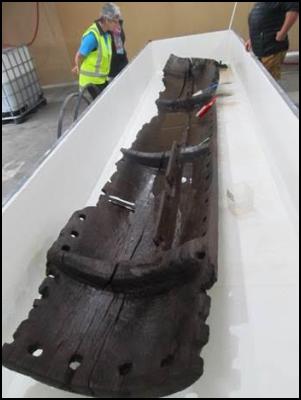Partnership Key to Restoration of Ancient Waka
Partnership Key to Restoration of Ancient
Waka

600 year-old waka discovered near the Anaweka estuary on the North West tip of the South Island
The
University of Auckland, Manawhenua ki Mōhua iwi and
Fonterra have embarked on a collaborative project to
preserve a 600 year-old waka – one of the South Island’s
most culturally significant discoveries.
The conservation partnership was initiated after the local Nichols family discovered the ancient waka near the Anaweka estuary on the North West tip of the South Island.
Manawhenua ki Mōhua iwi says the waka has attracted attention because of its detailed length of New Zealand matai and its extraordinary carving in the shape of a sea turtle on the hull.
“Turtle images are rare in pre-European carvings in New Zealand, suggesting the canoe’s Polynesian ancestral origins, with its last estimated journey around 1400AD. This was no small find, spanning just over six metres in length and 85 centimetres at its widest point (Johns 2014). [1]
“We are pleased that Fonterra has recently joined forces with us on this important on-going project, providing the new home for the canoe for the duration of its restoration.”
Fonterra’s Upper South Operations Manager Chris Win says the Co-operative was approached by elders from the local iwi to discuss the possibility of utilising one of the Takaka site’s buildings to house the waka.
“Given the importance of the discovery and the three years needed to restore it, the kaumatua were looking for somewhere big and secure where they could work on the waka – something we were proud to accommodate. Housing this waka has given our site the opportunity to be involved in an amazing piece of cultural history that is of great significance to our community.
“To witness the level of ownership, pride and understanding our staff have shown in this community project over the past few months has been extremely rewarding for everyone involved.”
University of Auckland Professor Dilys Johns has conducted a series of detailed conservation assessments over several months and planned a variety of treatments to provide structural strength to the wood, increasing the waka’s longevity.
“We have recently completed removal of chlorides and begun the next phase of treatment, providing stability for the degraded waka during drying.
“In addition to providing a unique example of pre-European maritime history, the conservation project will facilitate on-going relationships with the Manawhenua ki Mōhua iwi, local community, Fonterra and University of Auckland,” says Ms Johns.
This conserved piece of Māori heritage will be available to the public for viewing once treatment is complete and a suitable venue for exhibition has been decided.
[1] Johns, D.A. et. al. 2014 An early sophisticated East Polynesian voyaging canoe discovered on New Zealand’s coast Proceedings of the National Academy of Sciences 111(41) 14728-14733.
ENDS


 Wellington Access Radio: Young People Take Over Wellington Access Radio For Youth Broadcasting Week 2025
Wellington Access Radio: Young People Take Over Wellington Access Radio For Youth Broadcasting Week 2025 Dental for All: Community Groups, Oral Health Professionals Welcome The Green Party's Re-Commitment To Free Dental Care
Dental for All: Community Groups, Oral Health Professionals Welcome The Green Party's Re-Commitment To Free Dental Care Wikimedia Aotearoa New Zealand: Christchurch Hosting A Weekend For Wikipedians
Wikimedia Aotearoa New Zealand: Christchurch Hosting A Weekend For Wikipedians Brain Tumour Support New Zealand: Brainy Beanies Exhibition Comes To Christchurch In Support Of Brain Tumour Awareness Month
Brain Tumour Support New Zealand: Brainy Beanies Exhibition Comes To Christchurch In Support Of Brain Tumour Awareness Month  GPNZ: GPNZ Backs New Pay Equity Claim To Deliver The Same Fairness Won By Te Whatu Ora Nurses
GPNZ: GPNZ Backs New Pay Equity Claim To Deliver The Same Fairness Won By Te Whatu Ora Nurses Te Kowhai Print Trust: Celebrating Youth Empowerment And Creative Resistance Through Printmaking
Te Kowhai Print Trust: Celebrating Youth Empowerment And Creative Resistance Through Printmaking